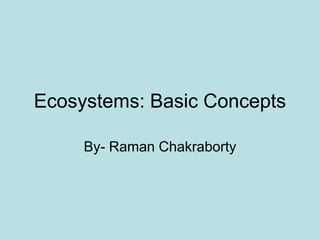
Ecosystem
- 1. Ecosystems: Basic Concepts By- Raman Chakraborty
- 2. What we will learn? • What is meant by an ecosystem • The biotic and abiotic community • Food chains, trophic levels, ecological pyramid • Water and carbon cycles (skip) • Benefits from ecosystem services
- 3. Some definitions • Ecosystem: Defined area in which a community lives with interactions taking place among the organisms between the community and its non- living physical environment. • An ecosystem is formed by the interactions between all living and non-living things • How do living and non-living things interact in an environment?
- 4. What is an ecosystem? • System = regularly interacting and interdependent components forming a unified whole • Ecosystem = an ecological system; = a community and its physical environment treated together as a functional system
- 5. Ecosystem Services • The human economy depends upon the services performed for free by ecosystems. • The ecosystem services supplied annually are worth many trillions of dollars. • Economic development that destroys habitats and impairs services can create costs to humanity over the long term that may greatly exceed the short-term economic benefits of the development. • These costs are generally hidden from traditional economic accounting, but are nonetheless real and are usually borne by society at large. – http://www.epa.gov/watertrain/pdf/issue2.pdf
- 6. Ecosystems: Fundamental Characteristics • Structure: – Living (biotic) – Nonliving (abiotic) • Process: – Energy flow – Cycling of matter (chemicals) • Change: – Dynamic (not static) – Succession, etc.
- 7. Abiotic components: • ABIOTIC components: • Solar energy provides practically all the energy for ecosystems. • Inorganic substances, e.g., sulfur, boron, tend to cycle through ecosystems. • Organic compounds, such as proteins, carbohydrates, lipids, and other complex molecules, form a link between biotic and abiotic components of the system.
- 8. BIOTIC components • The biotic components of an ecosystem can be classified according to their mode of energy acquisition. • In this type of classification, there are: • Autotrophs andHeterotrophs • Organisms that produce their own food from an energy source, such as the sun, and inorganic compounds. • Organisms that consume other organisms as a food source.
- 9. Trophic level: All the organisms that are the same number of food-chain steps from the primary source of energy
- 10. Trophic Levels • A trophic level is the position occupied by an organism in a food chain. • Trophic levels can be analyzed on an energy pyramid. • Producers are found at the base of the pyramid and compromise the first trophic level. • Primary consumers make up the second trophic level. • Secondary consumers make up the third trophic level. • Finally tertiary consumers make up the top trophic level.
- 11. Trophic Levels Found on an Energy Pyramid • The greatest amount of energy is found at the base of the pyramid. • The least amount of energy is found at top of the pyramid.
- 12. Trophic Structure Reminder • Eltonian pyramids • Number of individuals per species • Is this pyramid stable?
- 13. Trophic Structure Reminder • What if we transformed each species into biomass instead of absolute numbers?
- 14. Biomass • Energy is sometimes considered in terms of biomass, the mass of all the organisms and organic material in an area. • There is more biomass at the trophic level of producers and fewer at the trophic level of tertiary consumers. (There are more plants on Earth than there are animals.) • Bio=life Mass=weight • Bio + Mass = Weight of living things within an ecosystem.
- 15. Trophic Structure Reminder •Express trophic structure as energy transfer •Energy pyramids can never be inverted •Is there room for anyone else at the top of this food chain?
- 16. Food Chains • The producers, consumers, and decomposers of each ecosystem make up a food chain. • There are many food chains in an ecosystem. • Food chains show where energy is transferred and not who eats who.
- 17. Example of a Food Chain
- 18. Food Webs • All the food chains in an area make up the food web of the area.
- 19. Food web of a hot spring
- 20. Fig 6.5 Food web of the harp seal.
- 21. Ecology is The study of the distribution and abundance of organisms, AND the flows of energy and materials between abiotic and biotic components of
